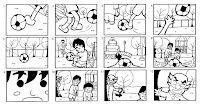Creating ideas: Paperwork
Creating ideas: Paperwork
Logistics Paperwork:
- Production schedule
- Call sheet
- Site structure diagram
- Asset log
- Risk assessment
- Recess
- Set design
1)Production Schedule definition
- Bring together logistics and resource details for a project
- Includes all tasks required plus the time-scales needed to get them done
- Used to track progress of project and make sure it's on track
- Shared with all members of production team so they are aware of when milestones are ad when deadlines need to be hit
Production schedules include:
2)Call Sheet
Logistics Paperwork:
- Production schedule
- Call sheet
- Site structure diagram
- Asset log
- Risk assessment
- Recess
- Set design
1)Production Schedule definition
- Bring together logistics and resource details for a project
- Includes all tasks required plus the time-scales needed to get them done
- Used to track progress of project and make sure it's on track
- Shared with all members of production team so they are aware of when milestones are ad when deadlines need to be hit
Production schedules include:
- Details of the initial proposal
- Key milestone agree with client as well as final deadlines
- Details of locations required, plus care details (transport, catering)
- Details of all resources - props, personnel, equipment
- Complete details of roles & responsibilities for each member of production team.
2)Call Sheet
- Used to plan logistics for each day of production
- Developed from production schedule, but offer more detail
Call sheet include:
- Developed from production schedule, but offer more detail
Call sheet include:
- Location details (address, map,transport detail)
- Crew details (personnel,contact details,times required)
- Health and safety notes (weather,protective clothing, hazards, closed roads)
- Transport schedule (who,where & when)
- Filming schedule (which tasks done and when)
- Equipment
Site structure:
- one diagram which outlines the purpose and content of each individual page on a website
- each page is given its own box
- lines are used to illustrate the web links between pages
- this is not a layout document, but more to do with simply breaking down the content of each page
- this can be circulated between the technical and creative teams who develop the idea from there
- looks at the hierarchy of pages, with the home page as the trunk and all others branching off.
- one diagram which outlines the purpose and content of each individual page on a website
- each page is given its own box
- lines are used to illustrate the web links between pages
- this is not a layout document, but more to do with simply breaking down the content of each page
- this can be circulated between the technical and creative teams who develop the idea from there
- looks at the hierarchy of pages, with the home page as the trunk and all others branching off.
Asset Log
-A document which lists all the elements or assets of a product
-It covers both content produced
by the production company and obtained from other sources
-This allows the company to keep track of copyright issues and permissions – making sure
that everything has permission granted before it hits market
The
asset log will contain:
1) What the asset
is
2) Details of
what the asset contains
3)Whether
permission is required and if so, whether it has been granted yet
Risk assessment
- Conducted on a visit
by the production company to all locations before production starts
- Identifies and health
and safety concerns
- Devises solutions to manage any hazards on location
- May include taking photographs
- Risk assessments protect
you, your crew, your actors and your equipment. They look at hazards which can harm and can effect
your production and put a PLAN B in place.
Recess
- Conducted at the same
time as risk assessment
- Judges suitability
of location
for production
- Will consider if it meets creative vision
- Will also consider logistical
issues –
accessibility with equipment, availability when required, cost
- Generally will recee
multiple locations for same scene – location which is best fit creatively &
logistically will be picked
Set Design
ìA visual
design of how the set
will look when set up
ìCould be 2D (a sketch) or
produced using 3D imaging software (in the exam, if asked, yours will be 2D)
ìWill include a visual representation of how the background and props will look in as much detail as possible
ìUsed by technical
team to them plan
camera positions and movements
ìMay include annotations to further explain elements of
set






Comments
Post a Comment